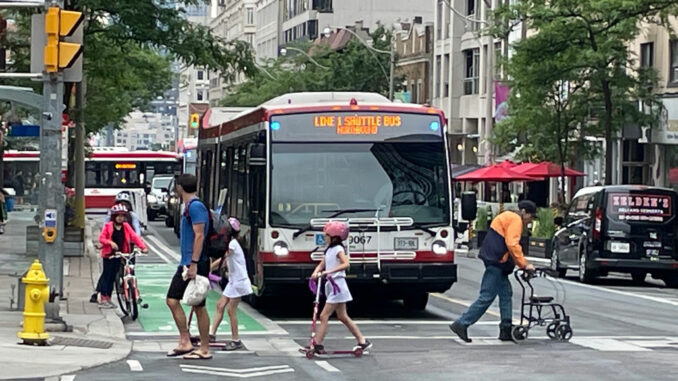
A new vision for our city streets is now here to stay. Following a positive staff report and the strong recommendation of the Infrastructure and Environment Committee, the mayor and 21 councillors listened to the evidence and voted in favour of making the Midtown Yonge Complete Street Pilot permanent. Complete streets are proving to be a key solution for calming traffic and boosting main street retail while also supporting the priorities of Vision Zero for road safety and TransformTO for Net Zero.
Since implemented in June 2021, the pilot has consistently delivered on its objectives – more people walking, up 132%; people biking up by as much as 180%, while vehicle volumes fell by up to 11%. On-street cafés increased from 10 to 21, providing more streetside ambience, and people noted that traffic was calmer, quieter, and the street felt safer. Throughout the pilot, staff made adjustments to address concerns through signal timing, additional turn lanes and design improvements. More of these types of adjustments are expected as the pilot transitions to a permanent installation.
So, why is this important for Leaside (besides offering us a protected cycling route to the Bloor/Danforth bikeway)? A complete street is coming to Eglinton (Phase 1 – Keele Street to Mt. Pleasant Road in 2023 and Phase 2 from Mt. Pleasant Road to Brentcliffe Road in 2024), and we will see a near-term proposal for the Leaside Neighbourhood Transportation Plan in a few weeks. These are opportunities to make sure we can all move safely through our neighbourhood and refashion Eglinton as a street where people want to walk and bike.
As Geoff Kettel noted in the February issue, Leaside is facing an influx of development proposals to complement new transit along Eglinton. Reviewing the eight developments Geoff identified, it is clear that the majority of residents and visitors are expected to walk, cycle and take transit. Collectively, the developments, which account for 2,822 units, offer 1,074 vehicle parking spots and 3,118 bicycle parking spaces. So, how do we design our streets for people to feel safe and make these climate-friendly transportation choices?
The Midtown Yonge Complete Street experience offers some insights. For example, shortening the distance for pedestrians to cross the street with curb extensions has the added benefit of slowing down turning vehicles. Incorporating leading pedestrian intervals (and bike signals) make these vulnerable road users more visible to drivers. Protected bike lanes encourage people to bike and provide a comfortable buffer between those walking and the vehicle traffic. Integrated transit stops are more accessible for people taking transit and safer for people on bikes. Narrowing travel lanes to make more space for everyone encourages slower vehicle speeds. And when more people walk, cycle or take transit, fewer cars are on the road, leaving more room for those who must drive.
With a complete street planned for Eglinton and consultations coming for the Leaside Neighbourhood Transportation Plan, let’s be proactive and ensure our streets offer safe, equitable and efficient options for everyone.


